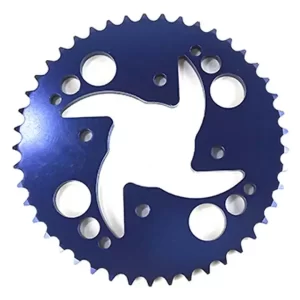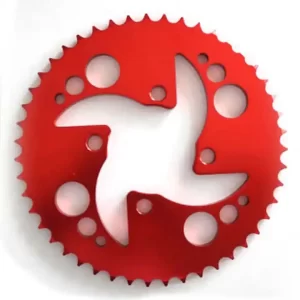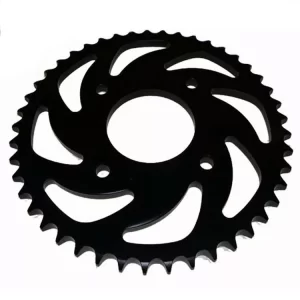Custom Front and Rear Dirt Bike Sprockets
Dirt bike sprockets come in various sizes and tooth configurations, allowing riders to customize their bike’s performance according to their specific needs.MPM is a leading manufacturer of motorcycle parts, including sprockets, chains, etc. We focus on details to ensure high quality, and can customize motorcycle parts in one stop. Our product quality and convenience have been recognized by the local and international markets under the “MPM” brand.
World Leading Sprocket Manufacturer
MPM is the world’s leading sprockets manufacturer for motorcycles and ATVs.
High Quality Sprockets
Leading technologies in materials and technologies Produced to ensure maximum durability
Strong Production Capacity
We offer the ultimate in custom sprockets that are unmatched
Get Fully Custom Sprockets
In our factory, we offer a wide range of motorcycle sprockets that are specifically tailored for Honda, Suzuki, Yamaha, Kawasaki, and other popular brands.
Custom Rear Sprockets
Customization options
- Dimensions
- Logo
- Package
- Color
Please provide accurate information/dimensions (or samples) to produce sprockets including:
- Center hole diameter
- Mounting bolt hole PCD [pitch circle diameter]
- Mounting bolt hole size
- Number of mounting bolt holes
- Do bolt holes need to be countersunk or recessed?
We can offer a wide range of color options, or a hard-anodized version with an integral surface (bronze) coating that significantly increases the hardness and wear resistance of the sprocket surface.
Custom Front Sprockets
Main information is as follows:
- Passed ISO 9001: 2000 standard.
- OEM motorcycle sprocket factory.
- Durable in use and nice.
- Color
- More than 10 years experience.
- The customer’s logo can be accepted.
mpm custom sprocket
MPM Universal Sprockets
-

Motorcycle kmx 125 rear sprocket for Kawasaki KMX125 KMX200
-

Custom aluminum motorcycle rear sprocket for Suzuki 150 Gixxer
-

Custom aluminum motorcycle rear sprocket for AKT TTX 180
-

Custom aluminum motorcycle rear sprocket for Kawasaki Ninja 250 300
-

Custom aluminum motorcycle rear sprocket for TVS Apache 200
-

Custom aluminum motorcycle rear sprocket for AKT CR5 180
-

Custom aluminum motorcycle rear sprocket for for AKT TTR 180 / P200
-

Custom aluminum motorcycle rear sprocket for Yamaha DT125
-

Custom aluminum motorcycle rear sprocket for YCF 150
-

Wholesale motorcycle rx115 sprocket
-

Custom aluminum motorcycle rear sprocket for Yamaha YZF-R3 MT-03
-

duke 200 chain sprocket
-

r15 v3 chain sprocket
-

KTM Aluminum Rear Sprocket 45T Duke390 for Motorcycle
-

HONDA CB250 Rear Sprocket 31T 520 for Motorcycle
-

SUZUKI GSXR125 Rear Sprocket 428 45T for Motorcycle
To achieve more speed on your dirt bike, you can consider changing the sprocket ratio. Increasing the rear sprocket size or decreasing the front sprocket size will result in a higher sprocket ratio, which can provide more top speed. This setup is often referred to as “taller gearing” or “higher gearing.”
By increasing the sprocket ratio, you sacrifice some low-end power and acceleration in exchange for a higher top speed. The engine will have to work harder to reach the same acceleration as before, but once it reaches higher speeds, the taller gearing allows for a greater top speed potential.
It’s important to note that changing the sprocket ratio solely for more speed may not be suitable for all riding conditions. Consider factors such as the terrain you ride on, your riding style, and the power characteristics of your dirt bike. If you primarily ride in tight and technical off-road trails that require quick acceleration, a more balanced sprocket ratio might be preferable.
Experimenting with different sprocket ratios and finding the right balance between acceleration and top speed can help you tailor your dirt bike’s performance to your specific needs and riding preferences. Remember to consider the limitations of your bike’s engine and transmission and ensure that the chosen sprocket ratio is within the safe operating range of your dirt bike.
Dirt bike rear sprockets are not universal and vary in size, design, and mounting configuration. While some dirt bike rear sprockets may have similar specifications and compatibility across different models and brands, it’s crucial to ensure that the rear sprocket you choose is specifically designed for your dirt bike’s make, model, and year.
Dirt bike rear sprockets are manufactured to fit specific hub patterns and may have variations in bolt hole spacing, offset, and tooth count. These specifications must match the requirements of your dirt bike’s rear wheel and drive system for proper installation and performance.
To determine the correct rear sprocket for your dirt bike, refer to your bike’s owner’s manual, contact the manufacturer, or consult with a reputable dirt bike parts supplier. They will provide you with accurate information regarding the compatible rear sprocket options for your specific dirt bike model.manufacturer, or consult with a reputable dirt bike parts supplier. They will provide you with accurate information regarding the
Installing an incompatible rear sprocket can lead to improper fitment, alignment issues, and potential damage to the sprocket, chain, or other drivetrain components. It’s always recommended to use the correct rear sprocket designed specifically for your dirt bike to ensure optimal performance, safety, and longevity.
A smaller rear sprocket on a dirt bike typically results in higher top speed but reduced acceleration. When the rear sprocket has fewer teeth, each rotation of the countershaft (front sprocket) will result in the rear wheel spinning more times. This means the bike can achieve a higher top speed for a given engine RPM. However, the trade-off is that the reduced number of teeth on the rear sprocket reduces the mechanical advantage, resulting in decreased torque and slower acceleration.
Conversely, a larger rear sprocket provides more mechanical advantage and increases torque, resulting in faster acceleration but lower top speed. With more teeth on the rear sprocket, each rotation of the countershaft causes the rear wheel to spin fewer times. This translates to quicker acceleration as more power is transferred to the rear wheel.
The choice of rear sprocket size depends on various factors, including the intended use of the dirt bike, riding conditions, rider preference, and the specific make and model of the bike. Riders who prioritize high-speed riding may opt for a smaller rear sprocket to achieve a higher top speed. On the other hand, riders focusing on off-road or trail riding may prefer a larger rear sprocket to enhance low-end power and acceleration.







